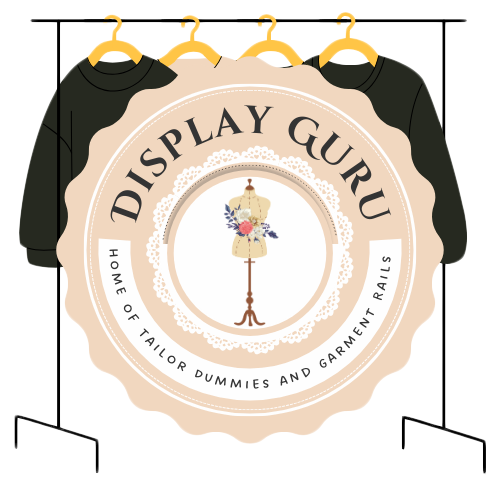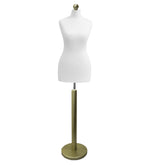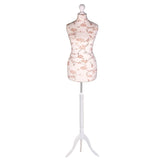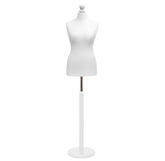10 Creative Shop Display Ideas to Boost Sales in 2025
In a competitive retail landscape, capturing a customer's attention is more challenging than ever. While online shopping offers convenience, the physical store provides an unparalleled opportunity to create an immersive brand experience. This is where strategic visual merchandising comes into play. The most effective shop display ideas do more than just showcase products; they tell a story, evoke emotion, and skilfully guide the customer journey from the window to the checkout. A well-executed display can be the deciding factor between a casual browser and a loyal customer, transforming your floor space into a dynamic and profitable environment.
This comprehensive guide moves beyond generic advice to explore ten innovative and practical shop display ideas designed to captivate your audience, enhance your products, and ultimately, drive sales. We will delve into specific, actionable strategies that you can implement immediately. From leveraging interactive technology and sensory elements to mastering the art of storytelling and sustainable design, these concepts will provide the tangible inspiration you need to revitalise your retail space. Prepare to discover how to turn your displays into your most powerful and persuasive sales tool.
1. Themed Window Displays: Your First Impression
Creating immersive, story-driven window displays is one of the most powerful shop display ideas for capturing public attention. These displays are your first, and often most critical, point of contact with potential customers, acting as silent salespeople that can stop foot traffic and communicate your brand's personality before anyone even steps inside. A compelling window display sets the tone for the entire shopping experience.
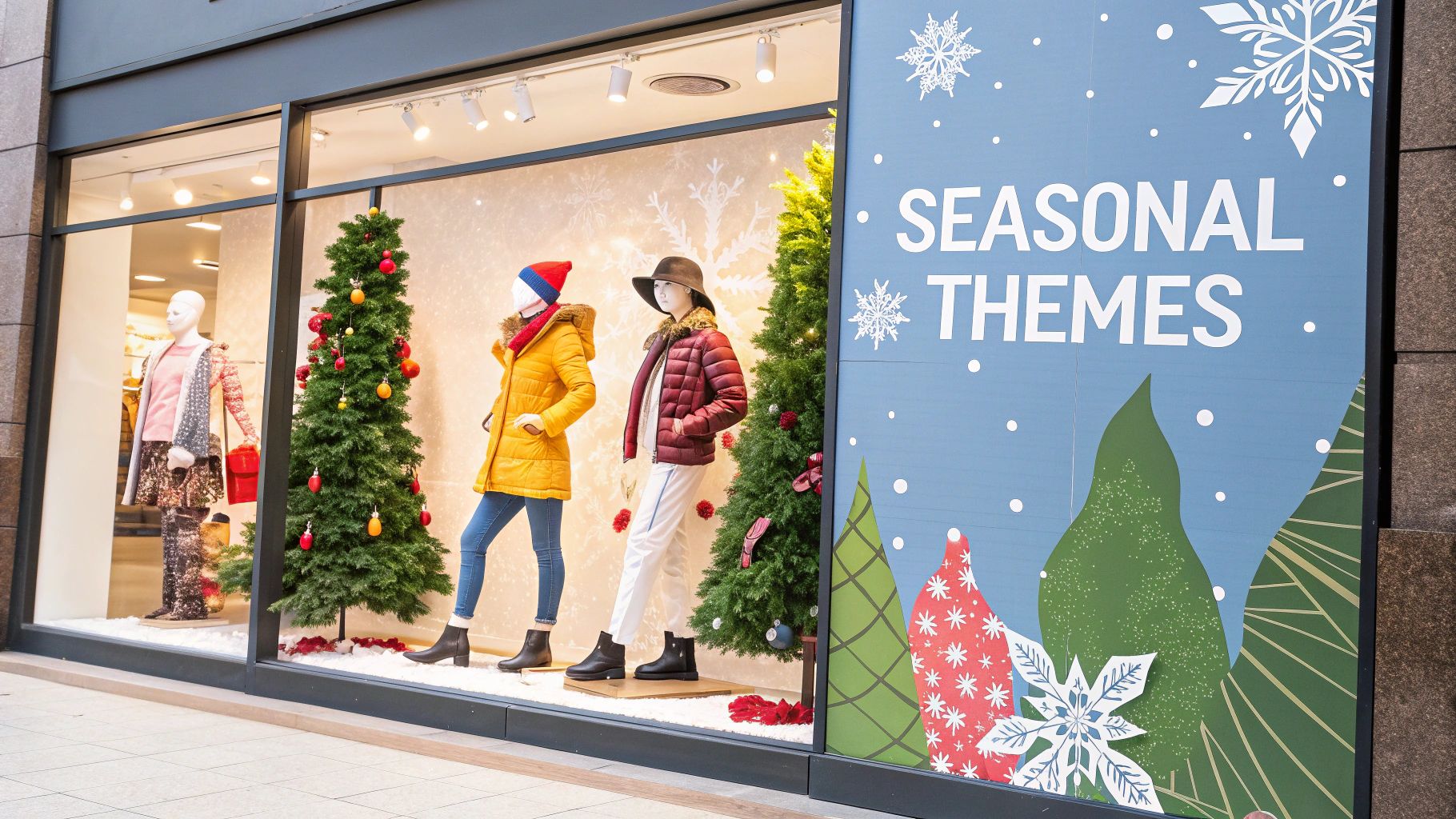
By rotating themes based on seasons, holidays, or local events, you keep your storefront looking fresh and create a sense of anticipation. This strategy has been perfected by luxury retailers like Harrods in London and Tiffany & Co., whose elegant showcases transform their windows into must-see attractions.
How to Implement Themed Displays
To execute this concept effectively, meticulous planning and a focus on visual principles are key. A well-organised approach ensures your display not only looks professional but also drives results.
- Plan Ahead: Develop your display calendar at least three to six months in advance. This lead time is crucial for sourcing props, finalising concepts, and ensuring a seamless installation.
- Create Visual Harmony: Utilise the 'pyramid principle' or group items in odd numbers (e.g., threes or fives) to create a more dynamic and visually appealing composition. This technique naturally guides the viewer's eye.
- Master Your Lighting: Incorporate layered lighting. Use focused spotlights to highlight hero products and softer ambient light to establish mood. Ensure your display is effective both day and night for maximum impact.
- Test Visibility: View your completed display from multiple angles-from across the street and from the typical paths of approach-to guarantee it captures attention from all perspectives.
Key Insight: For fashion retailers, investing in high-quality tailor's dummies is essential. Garments presented on impeccably formed mannequins become the centrepiece of your narrative, showcasing fit and fabric with professional precision. For a deeper exploration of this topic, you can learn more about impactful window display ideas on Display-Guru.co.uk.
2. Interactive Digital Displays
Integrating digital technology into your shop displays bridges the gap between the online and offline worlds, creating a dynamic and modern retail environment. Interactive displays use elements like touchscreens, augmented reality (AR), and QR codes to provide customers with engaging, personalised experiences that go beyond traditional static merchandising. This approach transforms passive browsing into active participation.
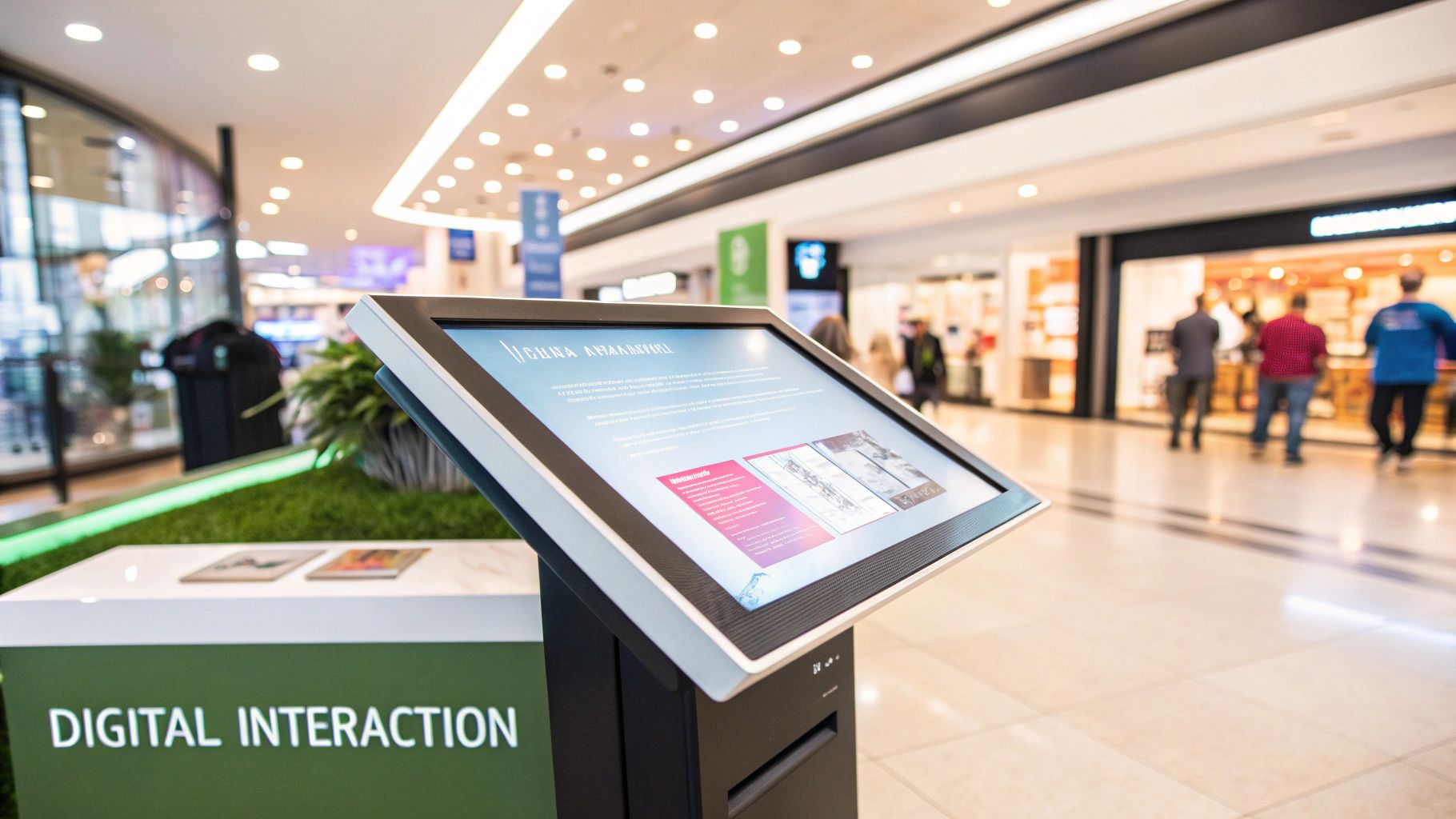
This innovative strategy is exemplified by brands like Sephora, whose "Virtual Artist" AR mirrors allow customers to try on makeup digitally, and Nike, which uses interactive stations for shoe customisation. These powerful shop display ideas not only capture attention but also provide valuable product information and streamline the customer journey, making the in-store experience more efficient and enjoyable.
How to Implement Interactive Displays
Successful execution requires a blend of user-friendly technology and strategic planning to ensure the displays enhance, rather than complicate, the shopping experience.
- Prioritise Accessibility: Position screens and interactive elements at a comfortable height for all users, including those in wheelchairs. Ensure interfaces are intuitive with clear, simple instructions for interaction.
- Ensure Reliability: Plan for technical issues by having backup systems or a clear protocol for troubleshooting. Regular software updates and hardware maintenance are crucial to prevent frustrating downtime.
- Empower Your Staff: Train your team to confidently assist customers with the technology. They should be able to guide users, answer questions, and resolve minor technical problems on the spot.
- Integrate Seamlessly: Link digital displays to your wider retail ecosystem. Use QR codes to direct customers to product pages, or connect interactive displays to your inventory system for real-time stock information.
Key Insight: The goal of digital displays is not just to dazzle but to add genuine value. An interactive screen showing how a bespoke suit can be customised offers a far more compelling experience than a simple poster, empowering customers and driving higher-value sales.
3. Product Grouping and Cross-Merchandising
Strategic product grouping is one of the most effective shop display ideas for increasing average transaction value. This technique involves arranging complementary items together to tell a story or offer a complete solution, guiding customers toward multiple purchases. By showing how different products work together, you remove guesswork and inspire customers to visualise the full potential of their purchase.
This approach is masterfully executed by retailers like IKEA, whose immersive room settings demonstrate how furniture, textiles, and accessories create a cohesive living space. Similarly, a fashion retailer like Zara styles mannequins with complete outfits, encouraging shoppers to buy the top, trousers, and accessories all at once, rather than just a single item.
How to Implement Product Grouping
Effective cross-merchandising goes beyond simply placing related items next to each other; it requires a thoughtful approach to visual storytelling and customer psychology. A well-organised display makes shopping intuitive and more enjoyable.
- Group by Solution or Lifestyle: Curate collections based on a specific need or theme. For example, a "Weekend Getaway" display could feature a travel bag, a comfortable outfit, a travel-sized cosmetic set, and a novel.
- Apply the 'Rule of Three': Arrange products in groups of three. This asymmetrical composition is more visually engaging and less static than pairs, naturally drawing the customer's eye across the display.
- Rotate Groupings Regularly: Keep your displays fresh by updating your product groupings to reflect new arrivals, seasonal trends, or promotional events. This encourages repeat visits from customers looking for new inspiration.
- Ensure Clear Pricing: While the display should look aspirational, ensure the price of each individual item is clearly and elegantly displayed to avoid customer frustration and cart abandonment.
Key Insight: For home goods or gift shops, create "vignettes" that mimic real-life scenarios. A coffee table display featuring coasters, a stylish mug, a book, and a small plant is more compelling than stacking these items on separate shelves. This method elevates products into a cohesive lifestyle concept. You can explore more about cohesive retail display solutions on Display-Guru.co.uk.
4. Vertical Display Systems
Maximising retail space by utilising wall height is a clever shop display idea that draws the customer's eye upwards and creates a sense of scale and abundance. This approach makes efficient use of limited floor space, particularly in smaller boutiques, while producing a dramatic visual impact. Vertical displays can transform an ordinary wall into a feature that showcases the breadth of your product range.
This technique is a hallmark of Japanese retail design, popularised by brands like MUJI and The Container Store, who use vertical systems to convey organisation and minimalist efficiency. It's also seen in large-scale formats, such as the floor-to-ceiling bookshelves in a Barnes & Noble or the colourful, stacked clothing walls in Uniqlo stores.
How to Implement Vertical Displays
Successful vertical displays require a balance of structural integrity, smart product placement, and accessibility. A well-planned vertical system feels impressive, not intimidating.
- Place Key Products at Eye Level: Position your best-sellers, high-margin items, or new arrivals between 1.2 and 1.5 metres from the floor. This is the prime visual real estate where most customers will naturally look first.
- Ensure Structural Stability: Safety is paramount. All shelving, racking, or fixtures must be securely anchored to the wall to handle the weight of the products. For very tall displays, consult a professional to ensure they meet safety standards.
- Illuminate Every Level: Don't let upper shelves get lost in the shadows. Integrate LED strip lighting under shelves or use adjustable track lighting to guarantee that products on higher levels are just as visible and appealing as those at eye level.
- Consider Accessibility: If customers need to access items on higher shelves, provide stylish and safe step stools. For 'show' stock on top shelves, ensure you have easily accessible inventory on the shop floor.
Key Insight: Vertical displays are not just about storage; they are about creating a visual journey. Using modular retail display stands allows you to build a custom, scalable system that can adapt to changing stock and promotions. For more inspiration, you can learn more about retail display stands on Display-Guru.co.uk.
5. Sensory Experience Displays: Engaging Beyond Sight
Moving beyond purely visual merchandising, sensory experience displays engage multiple senses to forge a deeper, more memorable connection with customers. These powerful shop display ideas incorporate touch, smell, sound, and sometimes taste, transforming a simple shopping trip into an immersive brand event. Engaging more than just sight helps to anchor memories and emotions, making customers feel more connected to your products and space.
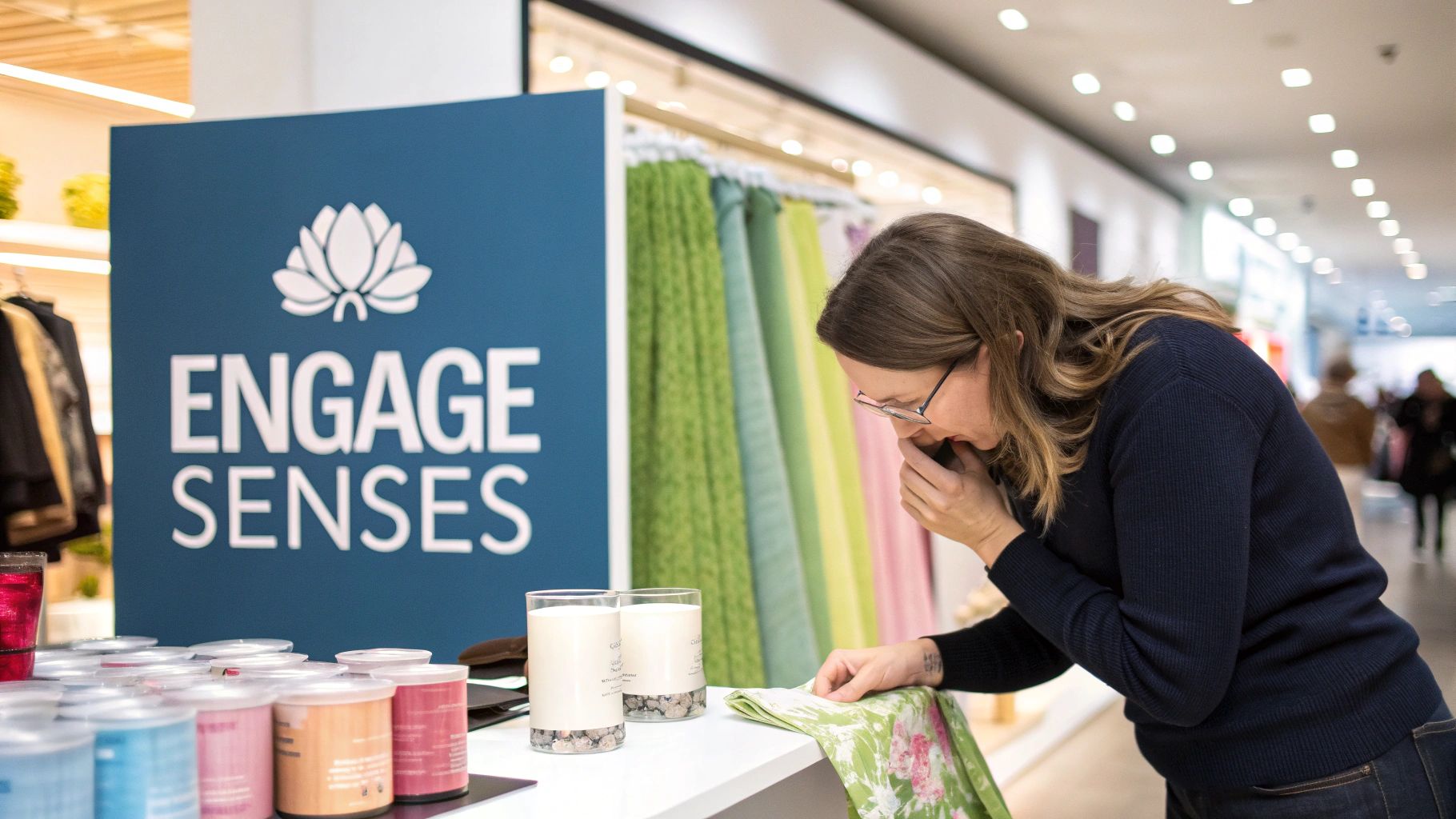
This multi-sensory approach has been championed by brands like Lush Cosmetics, whose stores are famous for their interactive product testing areas and distinctive scents that spill out onto the street. Similarly, the Apple Store’s hands-on device interaction zones invite customers to touch, use, and form a personal connection with the technology before purchasing.
How to Implement Sensory Displays
A successful sensory display is carefully curated to enhance the shopping experience without overwhelming it. The goal is to create a subtle yet impactful atmosphere that feels authentic to your brand.
- Integrate Relevant Scents: Use diffusers with a signature scent that complements your brand identity. A bookshop might use the smell of old paper and coffee, while a boutique selling linen garments could opt for a clean, fresh laundry fragrance.
- Encourage Tactile Interaction: Create "touch points" where customers can feel product textures. For a fashion retailer, this means having garments out of plastic wrapping and on rails, or displaying fabric swatches for customers to handle.
- Curate a Brand-Appropriate Soundtrack: Music significantly influences mood and shopping pace. Select a playlist that reflects your brand’s personality-be it calming ambient sounds for a wellness shop or an upbeat, modern mix for a trendy fashion store.
- Maintain Scrupulous Hygiene: For any display that encourages touch, cleanliness is paramount. Ensure surfaces are regularly cleaned and provide hand sanitiser nearby to build customer confidence and comfort.
Key Insight: The key to a successful sensory display is subtlety and relevance. The chosen elements should feel like a natural extension of your products, not a distracting gimmick. For instance, a tailor’s shop could enhance the experience by playing soft, classic music and offering a tactile wall of different wools, silks, and cottons.
6. Minimalist and Clean Displays: Less Is More
Adopting a minimalist design philosophy is a powerful shop display idea that prioritises simplicity, clean lines, and strategic use of negative space. This approach creates a sophisticated, uncluttered environment where the products themselves become the undisputed heroes. It conveys a sense of calm, quality, and confidence, inviting customers to focus on craftsmanship without distraction.
This aesthetic is famously championed by brands like Apple, whose stores are temples of modern simplicity, and Aesop, whose apothecary-style displays feel both scientific and luxurious. The core principle is that by removing visual noise, you enhance the perceived value of each item on display, making the shopping experience feel more considered and premium.
How to Implement Minimalist Displays
Effective minimalism is not about emptiness but about intention. Every element must be deliberate, from the materials used to the placement of each product, creating a harmonious and functional space.
- Invest in Quality Materials: Use high-quality, authentic materials like natural wood, polished concrete, or brushed metal for your fixtures. The texture and finish of these surfaces contribute significantly to the premium feel.
- Balance Minimalism with Warmth: A purely minimalist space can feel cold. Counteract this by incorporating warm, layered lighting and perhaps a touch of natural greenery. This makes the environment more inviting.
- Ensure Impeccable Presentation: Every product must be perfectly placed, aligned, and pristine. Maintain strict cleanliness standards, as dust and disarray are immediately noticeable in a minimalist setting.
- Focus on Functionality: Ensure your displays are not just beautiful but also practical. Products should be accessible and information easy to find, proving that simplicity can enhance the customer journey.
Key Insight: The success of a minimalist display hinges on the principle of "one thing well." Instead of overwhelming customers with choice, select a single hero product or a tightly curated group to feature on a surface. This focused presentation elevates the product's status and tells a confident story about its quality and design.
7. Pop-Up and Flexible Displays
In today's dynamic retail landscape, pop-up and flexible displays are essential shop display ideas for agility and innovation. These modular systems allow businesses to adapt quickly to changing merchandise, launch special promotions, or even take their brand on the road. From a farmers market stall to a high-concept temporary store, this approach offers unparalleled versatility.
This strategy has been famously employed by brands like Comme des Garçons with their "guerrilla stores" and Glossier with its destination pop-ups, proving that a temporary presence can generate significant, lasting brand excitement. The core benefit lies in creating a sense of urgency and exclusivity while testing new markets with minimal risk.
How to Implement Flexible Displays
Success with pop-up displays hinges on smart investment in systems and meticulous planning. The goal is to create a professional, stable, and consistently branded setup, regardless of the location or configuration.
- Invest in Quality Modular Systems: Choose durable, lightweight, and easy-to-assemble components. High-quality systems will withstand repeated use and maintain a professional appearance.
- Plan for Various Space Constraints: Design your display elements to be configurable for different layouts and footprints. This ensures your setup works as effectively in a small corner as it does in a large, open space.
- Create Setup Instruction Guides: Develop clear, visual guides for assembling and disassembling your display. This guarantees brand consistency and efficiency, especially if different staff members are responsible for the setup.
- Test Stability Before Use: Always perform a full assembly and stability check before adding valuable merchandise. Ensure all components are secure to prevent accidents and product damage.
Key Insight: For fashion retailers operating pop-ups or attending markets, the choice of clothing rail is critical. A robust yet lightweight system is non-negotiable for presenting garments effectively and safely. For more guidance, you can learn more about portable clothing racks on Display-Guru.co.uk.
8. Lighting-Focused Displays: Sculpting with Light
Strategic lighting is one of the most transformative shop display ideas, capable of sculpting space, creating atmosphere, and directing customer focus with surgical precision. Rather than simply illuminating a store, a lighting-focused display uses light as the primary design tool to highlight products, evoke emotion, and guide the customer journey. This technique elevates merchandise from simple objects to coveted treasures.
A masterful lighting scheme can dramatically alter the perception of a product. Luxury brands like Tiffany & Co. use precisely calibrated lighting to maximise the sparkle of their diamonds, while cosmetic retailers like MAC use high-CRI (Colour Rendering Index) lighting at their counters to ensure makeup colours appear true to life. This deliberate use of light is what separates an average retail space from an immersive brand experience.
How to Implement Lighting-Focused Displays
Executing a lighting-focused display requires a layered approach that considers function, mood, and aesthetics. The goal is to create a visual hierarchy that feels both intentional and natural.
- Layer Your Lighting: Combine different types of light. Use ambient lighting for overall illumination, accent lighting (like spotlights) to highlight hero products, and decorative lighting to add character and reinforce your brand identity.
- Prioritise Colour Accuracy: For products where colour is critical, such as fashion or cosmetics, use bulbs with a high CRI (90+). This ensures that colours look the same in-store as they do in natural daylight, reducing returns and increasing customer satisfaction.
- Control the Mood: Use warm-toned lighting (around 2700-3000K) to create a cosy, welcoming, and luxurious atmosphere. Cooler tones can feel more modern and energetic, suitable for tech or sportswear environments.
- Eliminate Unwanted Shadows: Position lights carefully to ensure products are evenly illuminated without casting harsh shadows that obscure details. View displays from multiple customer vantage points to check for glare or dark spots.
Key Insight: Dynamic lighting, such as subtle shifts in intensity or colour, can keep a display feeling fresh and engaging. Tech leaders like ERCO specialise in architectural lighting systems that allow retailers to program different scenes for day, night, or special promotions, making your displays work harder around the clock.
9. Storytelling Displays: Crafting an Emotional Connection
Moving beyond simply showcasing products, storytelling displays weave a narrative that captivates shoppers on an emotional level. This technique transforms merchandise into part of a larger, more engaging story, communicating brand values and creating a memorable experience. A successful storytelling display makes the customer feel like they are part of a narrative, not just a spectator in a shop.
This approach is masterfully executed by retailers like Anthropologie, whose whimsical lifestyle vignettes make you feel as though you've stepped into a beautifully curated home. Similarly, Patagonia often uses its displays to tell powerful stories of environmental activism, connecting its gear to a greater purpose and resonating deeply with its target audience.
How to Implement Storytelling Displays
To build a narrative that sells, you must connect your brand's core identity with your products through a cohesive visual story. A well-planned narrative guides the customer's perception and builds brand loyalty.
- Define Your Narrative: Keep your story authentic and aligned with your brand's core values. Is it a farm-to-table journey for a food product, or an athlete's triumph for sportswear? The narrative must be genuine to be effective.
- Establish a Visual Hierarchy: Use props, lighting, and placement to guide the customer's eye through the story. The product should always be the hero of the narrative, not overshadowed by props.
- Incorporate Multiple Touchpoints: Extend the story beyond the main display. Use signage, product tags, or even QR codes to provide deeper context and enrich the customer's engagement with the narrative.
- Keep It Fresh: Regularly update your stories to maintain customer interest and give them a reason to return. A static display can quickly become part of the background, but an evolving story creates anticipation.
Key Insight: The power of storytelling lies in its ability to forge a strong emotional bond. When customers connect with your brand's story, they are not just buying a product; they are buying into the values and lifestyle it represents. For more guidance on creating compelling narratives, you can explore visual merchandising guidelines on Display-Guru.co.uk.
10. Sustainable and Eco-Friendly Displays
Integrating eco-conscious principles into your visual merchandising is a powerful shop display idea that resonates deeply with modern consumers. Sustainable displays demonstrate your brand's commitment to environmental responsibility, using recycled materials, reclaimed items, and energy-efficient designs. This approach not only enhances your brand image but also aligns with the growing consumer demand for ethical business practices.
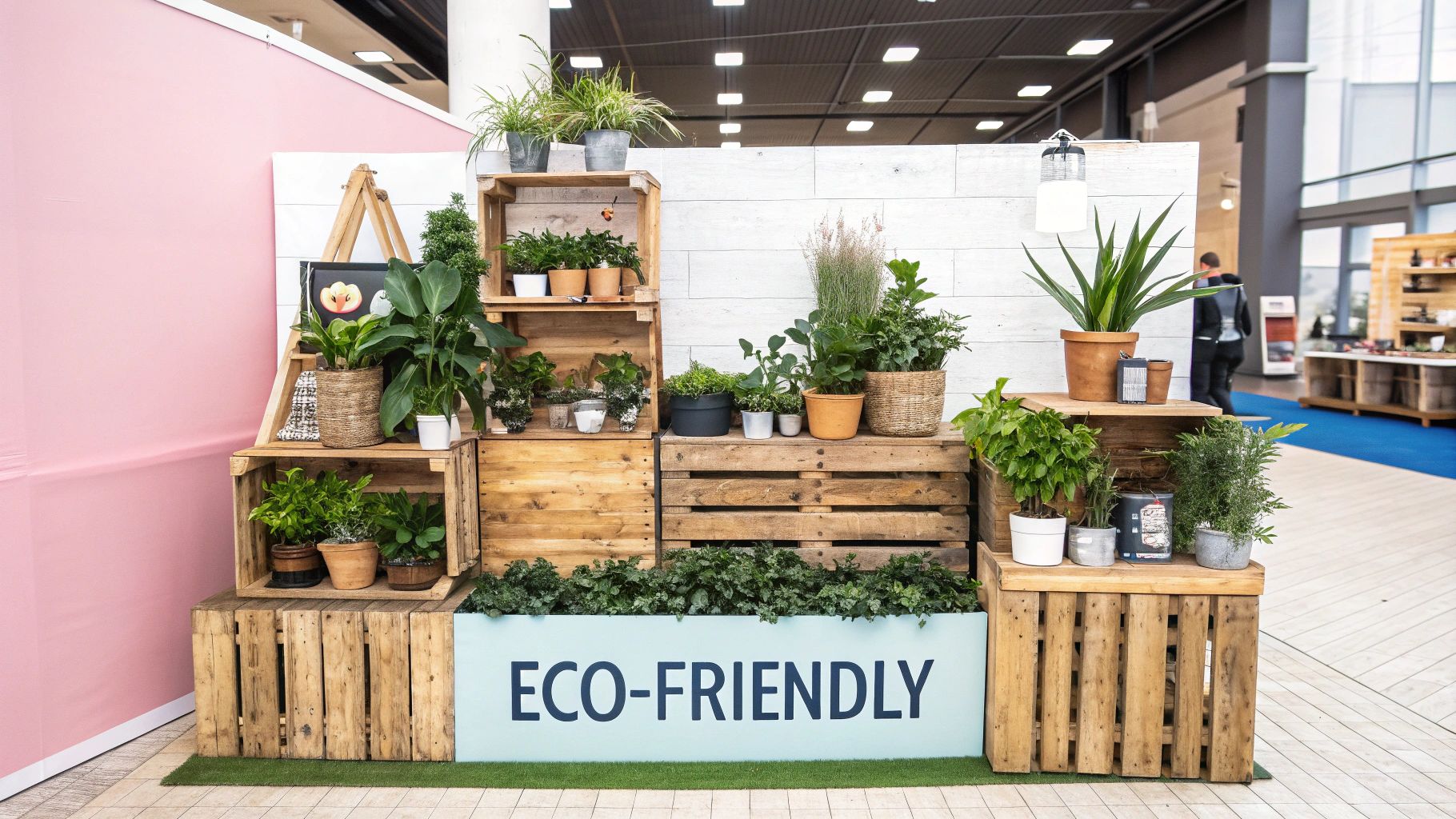
This philosophy has been championed by brands like Patagonia, which utilises reclaimed wood, and Eileen Fisher, known for using recycled materials in its store fixtures. These displays do more than just showcase products; they communicate a core brand value, fostering a stronger connection with customers who share those principles.
How to Implement Eco-Friendly Displays
Executing a sustainable display strategy involves thoughtful material sourcing and a focus on the entire lifecycle of your fixtures. The goal is to create beautiful, effective displays that minimise environmental impact.
- Source Materials Locally: Reduce your carbon footprint by sourcing materials like reclaimed wood, recycled metal, or even upcycled cardboard from local suppliers or artisans.
- Design for Disassembly: Create modular displays that can be easily taken apart, reconfigured, and reused for future campaigns. This extends the life of your materials and reduces waste.
- Tell Your Story: Use small signs or tags to explain the sustainable origins of your display materials. Communicating this story to customers adds value and transparency to their shopping experience.
- Prioritise Energy Efficiency: Use LED lighting, which consumes significantly less energy and has a longer lifespan than traditional bulbs, to illuminate your sustainable setups.
Key Insight: Look beyond the initial purchase price and consider the lifecycle cost of your display materials. Investing in durable, reusable, and recyclable elements often proves more cost-effective and environmentally sound in the long run, reflecting a genuine commitment to sustainability.
Shop Display Ideas Comparison Matrix
| Display Type | Implementation Complexity 🔄 | Resource Requirements ⚡ | Expected Outcomes 📊 | Ideal Use Cases 💡 | Key Advantages ⭐ |
|---|---|---|---|---|---|
| Themed Window Displays | Medium - high | Moderate (materials, design time) | High foot traffic, brand buzz | Seasonal promotions, holidays | High visibility; cost-effective; brand personality |
| Interactive Digital Displays | High | High (tech, maintenance) | Detailed info, customer engagement | Tech-focused retail, modern stores | Instant info; data collection; remote updates |
| Product Grouping & Cross-Merchandising | Medium | Moderate (staff training, reorg) | Increased sales, simplified shopping | Complementary products, lifestyle sets | Boosts average purchase; visual merchandising |
| Vertical Display Systems | Medium | Moderate (shelving, safety) | Space maximization, dramatic visuals | Stores with limited floor space | Efficient space use; large inventory capacity |
| Sensory Experience Displays | High | High (multi-sensory elements) | Emotional connection, longer dwell time | Beauty, food, experiential products | Memorable experience; differentiates from online |
| Minimalist and Clean Displays | Medium | Moderate (high-quality materials) | Premium brand perception, reduced clutter | Premium brands, product-focused spaces | Timeless aesthetic; easy maintenance |
| Pop-Up and Flexible Displays | Low - medium | Low - moderate (modular materials) | Adaptability, cost-effective temporary use | Seasonal/promotional or mobile setups | Flexible, quick setup; portable |
| Lighting-Focused Displays | Medium | Moderate (lighting infrastructure) | Enhanced product appeal, mood creation | High-end retail, product spotlighting | Dramatic effect; energy efficient with LEDs |
| Storytelling Displays | High | High (props, staging, design) | Emotional brand connection, memorable UX | Brand differentiation, experiential retail | Engages customers emotionally; social sharing potential |
| Sustainable & Eco-Friendly Displays | Medium | Moderate to high (materials sourcing) | Positive brand image, environmental impact | Eco-conscious brands, corporate responsibility | Appeals to green consumers; unique aesthetics |
Transforming Your Space: Putting These Ideas into Action
The journey from a spark of inspiration to a fully realised, customer-captivating display is where retail success is truly forged. Throughout this guide, we have explored a diverse range of shop display ideas, from the immersive power of themed windows to the conscious appeal of sustainable merchandising. Each concept offers a unique pathway to transform your retail space from a simple point of sale into a memorable brand destination.
The core takeaway is that effective visual merchandising is not about adopting every trend, but about strategic selection. It involves a thoughtful curation of techniques that authentically reflect your brand’s story and resonate deeply with your target audience. A minimalist boutique might focus on sophisticated lighting and clean lines, while a vintage clothing store could thrive by creating rich, narrative-driven displays. The most powerful approaches often involve a creative fusion of these concepts, proving that exceptional shop display ideas are rarely one-dimensional.
Your Action Plan for Display Excellence
To translate these concepts into tangible results, a structured approach is essential. Avoid the temptation to overhaul everything at once. Instead, begin with a critical assessment of your current environment and identify areas with the most potential for immediate impact.
- Audit and Identify: Start by walking through your shop as a customer would. Which areas feel uninspired or overlooked? Is your window display telling a compelling story, or is it merely showcasing products? Pinpoint one or two key zones, such as your entrance or a high-traffic wall, to begin your transformation.
- Align and Select: Revisit the ten display strategies we've discussed. Which ones align most closely with your brand identity and customer profile? A shop catering to eco-conscious consumers should prioritise sustainable materials, while a tech-focused retailer might invest in an interactive digital display. Choose a primary strategy for your test area.
- Experiment and Combine: Do not be afraid to blend elements. You can enhance a product grouping display with sensory elements like a subtle scent or a specific texture. A pop-up display can be made more effective with focused, dramatic lighting. This layered approach creates a richer, more engaging experience for your customers.
- Measure and Refine: The world of retail is dynamic, and your displays should be too. Track customer behaviour, monitor sales of featured items, and solicit feedback. Use these insights to refine your approach. Visual merchandising is an ongoing dialogue with your audience, not a one-time setup.
By embracing this process of continuous improvement, you move beyond just decorating a space. You begin to strategically engineer an environment that guides, delights, and converts. Investing in creative and well-executed shop display ideas is a direct investment in your brand’s perceived value and your connection with every person who walks through your door. It is the silent salesperson that works around the clock to build loyalty and drive your business forward.
Ready to bring your vision to life with professional-grade equipment? Explore the extensive collection of mannequins, garment rails, and display solutions at Display Guru. Find the perfect tools to build stunning, effective displays that capture attention and elevate your brand at Display Guru.
